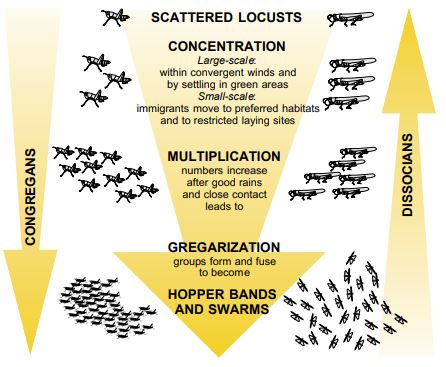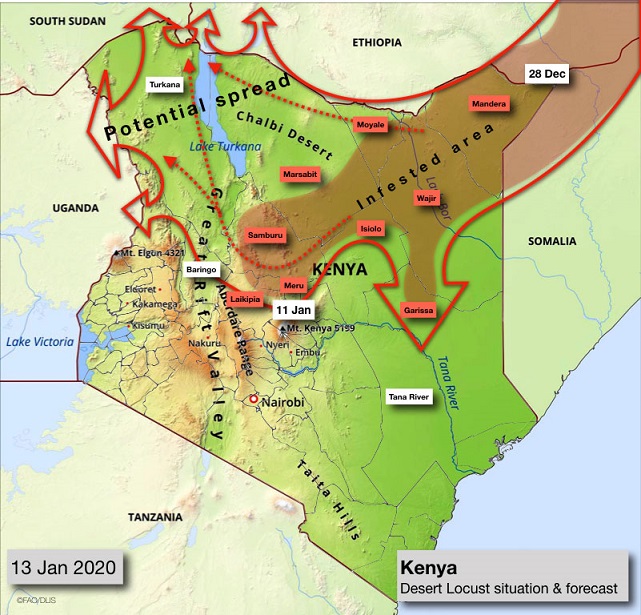Desert locust plagues leave a trail of death and destruction on their path. Their appearance shows a famine coming. The current invasion is the worst in 25 years. It started in Yemen over 18 months ago and has spread in vast regions in the Middle East, the Horn of Africa and Asian Countries. In this post, we focus on the impact of desert locusts in Kenya. They have threats to food security, farmers income and livelihoods.
FAO classifies desert locust as the most dangerous migratory pest. it endangers the livelihoods of over 10 million people across Africa and Asia. They are an international threat to food security and economic livelihoods for a tenth of the world population. Additionally, they also pose health and environmental risks and may endanger air transport. Locusts invaded Kenya on 28th December 2019.
There have been six major plagues of Desert Locusts in the 1900s that occurred in Kenya from 1926-1934, 1940-1948, 1949-1963, 1967-1969 and 1986-1989. In colonial Kenya, the first plague invasion was in February 1928. This lasted till 1930. 1931 experienced a new wave of invasion and it lasted to1932. Later invasions would occur in the 1930 and 1940s leading to the creation of the DLCO-EA regional body to coordinate control of future invasions.
What you need to know about desert locusts

Locusts are grasshoppers that are “high” on serotonin, with bigger heads and enlarged brains. Desert locusts or the Schistocerca gregaria are members of the horned grasshopper’s family Acrididae. The major difference between locusts and grasshoppers is their ability to metamorphose in behaviour, physiology and morphology.
Normally they exist as isolated insects during the solitarious phase. In high rainfall, warm temperatures and vegetation bloom conditions the insects may congregate together. They further multiply and concentrate into unstoppable and destructive matching hopper bands or flying swarms. A single swarm can contain between 40 million to 80 million individual adult locusts behaving as a single unit. These can cover large tracts of land extending over tens of kilometres. The immature non-flying nymphs or hoppers form matching bands. A locust Swarm or hopper band is a cohesive mass of hoppers that persists, behaves and moves as a unit.
The Impact of desert locust in Kenya
When a locust plague has fully developed, it is almost impossible to stop or control from spreading. During the recession phase, you will find desert locusts in around 30 countries spread in Africa, the Middle East, and Asia that receive less than 200mm of rainfall in the Sahel and the Indo-Pakistan desert regions. In a full-blown plague, they may spread to 29 million square kilometres in over 60 countries. This can affect 20 per cent of the total land surface directly threatening the economic livelihood of 1o per cent of the world’s human population.
Food insecurity
Locust swarms directly devastate food crops and foliage causing huge declines in plant and animal production. They can clear acres of green fields in hours leaving brownfields in their path. Their destruction can cause 80–100 per cent crop loss.
They devour all crops including vegetables, cereal crops, bananas, citrus trees, groundnuts, fruit trees and coffee. This leads to significant losses in food crops, cash crops and animal fodder. Destruction of animal fodder leads to decreased livestock production for subsequent seasons.
In the 1931 Kenyan locust invasion, reports up to the end of August that year show farmers lost 50 per cent of maize and wheat in Nzoia Province. Losses in Nyanza Province were around 70 per cent, 25 per cent in Rift Valley while other areas experienced a 10 per cent crop loss. In December 2019, Locusts had destroyed over 70,000 hectares or 175,000 acres of farmland in Somalia and Ethiopia. This has made it one of the worst locust invasion in 70 years according to FAO. In 2006, an Invasion in Mauritania left at least 60% of West Africa’s country’s population or 400,000 people dependent on food aid.
This situation is too aggravated by high rainfall and flooding that occur before their invasion.
Economic Livelihoods
Locust plagues can directly threaten the economic livelihood of 10% of the world’s human population. We associate this threat to loss of agricultural income in most African and Asian susceptible countries. There is also a high cost of controlling those infestations for vulnerable smallholder farmers and nomadic pastoralists.
Maize losses of the 1931 invasion were over £ 175,000. Damages in wheat, sugarcane and other small crops were valued at £ 75,000. Locust outbreaks and plagues control is very costly for governments, farming organizations and individual farmers. In the last major plague of 2003–2005, in West Africa, it cost over $500 million to control.
Locust invasion is a huge contributor to poverty and inhibits farmer’s ability to cater to their food, health and education and other needs.
Health
Though locusts can be cannibalistic during vegetation scarcity, they do not attack people or animals. However, they are a common cause of insect allergens.
Their hormones and pheromones produced during mating season, wing scales and cuticles are common respiratory tract nuisances. This health menace is further worsened by the increased presence of dust in the air from destroyed farm fields experiencing wind soil erosion.
Ecological destruction
Desert locusts can clear acres of green fields in hours leaving brownfields in their path. They consume all edible leaves and stems for a range of crops.
In overstocked grazing areas, locust invasions increase stress on already overfed shrubs and trees. This may lead to a subsequent impact on soil quality. This results from soil degradation by exposing topsoil to direct sunlight. This will improve soil dehydration and wind erosion promoting the desertification process.
Some pesticides used in the chemical control of locusts may have negative effects on human, livestock, and environmental health.
What makes the desert locust so destructive?

Desert locusts pose such a huge threat to food security, livelihoods and the environment. What makes them so destructive is their fast breeding, agility, excessive feeding and their swarming nature making them highly destructive and difficult to defeat.
Fast Breeding
Locust breeding is highly logarithmic under high rainfall and temperatures. A single female can produce up to 16-20 viable locusts in a single generation under favourable conditions. This means you may end up having 500 times the number of locusts within 6 months.
The Desert Locust life cycle follows that of the normal grasshopper. A female adult lays around 80 eggs in the gregarious phase and between 90 and 160 in the solitarious phase. The female locust bores holes deep into the ground to lay eggs 5-10 cm below the soil surface. This reproduction rate is so high to control. One immature swarm was 60 km long by 40 km wide in the northeast according to Ethionews.
Fast Movement
Locust Swarms can fly at a speed of 16-19 km/h depending on the speed of the prevailing wind. They do not fly at night or when it’s very hot. In a day they can cover up to 150 km in a downwind direction.
The desert locusts can migrate over long distances sometimes across continents. The current invasion in East Africa started in Yemen. Locusts crossed over the Red Sea, a distance of around 300 km. In 1954, the locusts flew from North-West Africa to the British Isles. The most spectacular migration was in 1988. In around 10 days, they made a trans-Atlantic cross a distance of 5000km.
Excessive Feeding
Locust swarms devour every crop they come across on their path. Each locust eats its weight (around 2 grams) of plants each day. According to FAO, A 1 km2 size swarm containing about 40 million locusts will destroy plants equivalent to 80 metric tons of edible leaves and stems. This is equivalent to the food intake of 20 camels or 6 elephants. This amount can feed 35,000 people each consuming 2.3 kg of food per day.
As of today, at least 12 large swarms had invaded Kenya. Five were still being controlled.
Control measures
Once developed, a locust plague is almost impossible to stop or control. The desert locust control methods seek to stop an outbreak by messing with the desert locust’s lifecycle. Methods include destroying egg masses laid by invading swarms, digging trenches to trap marching nymphs before they can mature to invade new areas and reproduce.
Methods to control flying swarms, include the use of hopper dozers (wheeled screens that cause locusts to fall into troughs containing water and kerosene), using insecticidal baits, and aerial fumigation using insecticides to both swarms and breeding grounds from aircraft.
Migratory locusts can also be blessings in disguise. The insects are highly nutritious in proteins, fatty acids and minerals. You can capture and use them as human food, or raw materials to manufacture animal feed.



